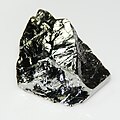Carbon group
Carbon Group
The Carbon Group refers to the chemical elements in group 14 of the periodic table, which includes carbon (C), silicon (Si), germanium (Ge), tin (Sn), and lead (Pb). These elements share similar properties, including the ability to form four bonds, which makes them crucial in various chemical processes and materials. This article delves into the characteristics, applications, and significance of the carbon group elements.
Characteristics[edit]
The carbon group elements exhibit a mix of metallic and non-metallic properties. Carbon, the first element of the group, is a non-metal, while silicon and germanium are metalloids, and tin and lead are metals. As we move down the group, the metallic character increases due to a decrease in ionization energy and an increase in atomic size.
Atomic and Physical Properties[edit]
- Carbon is well-known for its allotropes, including diamond, one of the hardest known materials, and graphite, which is soft and used as a lubricant.
- Silicon and germanium have semiconductor properties, making them essential in the electronics industry, especially in the manufacture of diodes, transistors, and solar cells.
- Tin and lead are malleable and have low melting points compared to the other group 14 elements. Tin is often used in alloys, while lead has been historically used in batteries and pipes.
Chemical Properties[edit]
The carbon group elements tend to form covalent compounds. Carbon forms a vast number of compounds, more than any other element, due to its ability to catenate, or form chains of identical atoms. Silicon and germanium also form similar chains and rings, but to a lesser extent.
Applications[edit]
- Carbon is fundamental to life as the backbone of organic chemistry. It is also used in steelmaking, as a filter, and in its graphite form as a lubricant.
- Silicon is crucial in the production of electronic devices due to its semiconducting properties. It is also used in the manufacture of glass, concrete, and ceramics.
- Germanium is used in fiber optics, infrared optics, and in the production of semiconductors.
- Tin is used in solder, due to its low melting point, and in various alloys such as bronze.
- Lead has been used in batteries, ammunition, and as a radiation shield.
Environmental and Health Concerns[edit]
Lead is toxic, and its use has been significantly reduced in many applications to prevent lead poisoning. The other elements of the carbon group also have environmental and health impacts, particularly in the context of mining and disposal of electronic waste.
Conclusion[edit]
The carbon group elements are integral to both the natural world and human technology. Their unique properties enable a wide range of applications, from the fundamental building blocks of life to advanced electronic devices. However, the environmental and health impacts of these elements, especially lead, require careful management and regulation.
Carbon group gallery[edit]
-
Diamond and graphite with scale
-
Silicon Croda
-
Polycrystalline germanium
-
Sn Alpha Beta
-
Lead electrolytic and 1cm3 cube
Ad. Transform your life with W8MD's Budget GLP-1 injections from $75


W8MD offers a medical weight loss program to lose weight in Philadelphia. Our physician-supervised medical weight loss provides:
- Weight loss injections in NYC (generic and brand names):
- Zepbound / Mounjaro, Wegovy / Ozempic, Saxenda
- Most insurances accepted or discounted self-pay rates. We will obtain insurance prior authorizations if needed.
- Generic GLP1 weight loss injections from $75 for the starting dose.
- Also offer prescription weight loss medications including Phentermine, Qsymia, Diethylpropion, Contrave etc.
NYC weight loss doctor appointmentsNYC weight loss doctor appointments
Start your NYC weight loss journey today at our NYC medical weight loss and Philadelphia medical weight loss clinics.
- Call 718-946-5500 to lose weight in NYC or for medical weight loss in Philadelphia 215-676-2334.
- Tags:NYC medical weight loss, Philadelphia lose weight Zepbound NYC, Budget GLP1 weight loss injections, Wegovy Philadelphia, Wegovy NYC, Philadelphia medical weight loss, Brookly weight loss and Wegovy NYC
|
WikiMD's Wellness Encyclopedia |
| Let Food Be Thy Medicine Medicine Thy Food - Hippocrates |
Medical Disclaimer: WikiMD is not a substitute for professional medical advice. The information on WikiMD is provided as an information resource only, may be incorrect, outdated or misleading, and is not to be used or relied on for any diagnostic or treatment purposes. Please consult your health care provider before making any healthcare decisions or for guidance about a specific medical condition. WikiMD expressly disclaims responsibility, and shall have no liability, for any damages, loss, injury, or liability whatsoever suffered as a result of your reliance on the information contained in this site. By visiting this site you agree to the foregoing terms and conditions, which may from time to time be changed or supplemented by WikiMD. If you do not agree to the foregoing terms and conditions, you should not enter or use this site. See full disclaimer.
Credits:Most images are courtesy of Wikimedia commons, and templates, categories Wikipedia, licensed under CC BY SA or similar.
Translate this page: - East Asian
中文,
日本,
한국어,
South Asian
हिन्दी,
தமிழ்,
తెలుగు,
Urdu,
ಕನ್ನಡ,
Southeast Asian
Indonesian,
Vietnamese,
Thai,
မြန်မာဘာသာ,
বাংলা
European
español,
Deutsch,
français,
Greek,
português do Brasil,
polski,
română,
русский,
Nederlands,
norsk,
svenska,
suomi,
Italian
Middle Eastern & African
عربى,
Turkish,
Persian,
Hebrew,
Afrikaans,
isiZulu,
Kiswahili,
Other
Bulgarian,
Hungarian,
Czech,
Swedish,
മലയാളം,
मराठी,
ਪੰਜਾਬੀ,
ગુજરાતી,
Portuguese,
Ukrainian




